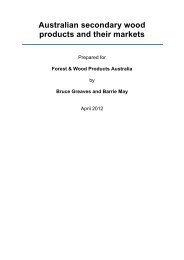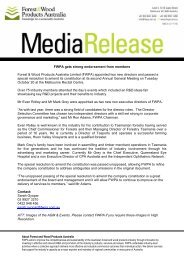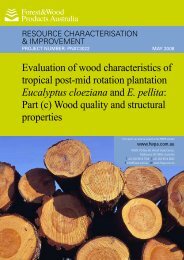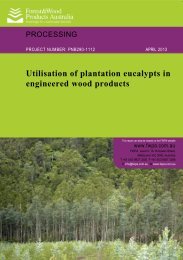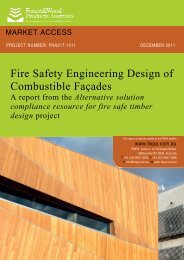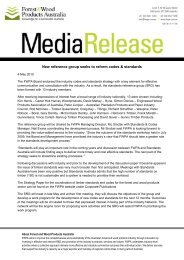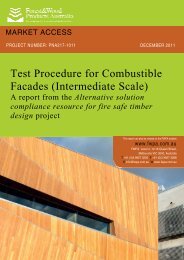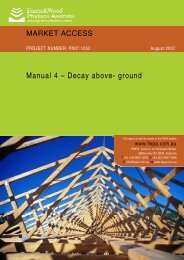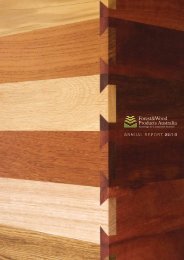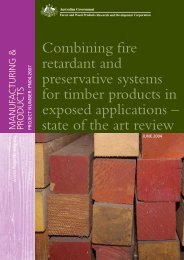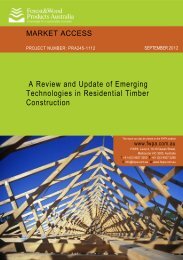guide to the specification, installation and use of preservative treated ...
guide to the specification, installation and use of preservative treated ...
guide to the specification, installation and use of preservative treated ...
You also want an ePaper? Increase the reach of your titles
YUMPU automatically turns print PDFs into web optimized ePapers that Google loves.
Page | 20<br />
GUIDE TO THE SPECIFICATION, INSTALLATION<br />
AND USE OF PRESERVATIVE TREATED<br />
ENGINEERED WOOD PRODUCTS<br />
Marine borer resistance.<br />
AS 5604 defines <strong>the</strong> natural durability rating as <strong>the</strong> inherent<br />
resistance <strong>of</strong> <strong>the</strong> heartwood <strong>of</strong> a timber species <strong>to</strong> those<br />
hazards. For example <strong>the</strong> heartwood <strong>of</strong> spotted gum,<br />
merbau (kwila) <strong>and</strong> cypress pine are resistant <strong>to</strong> termite<br />
attack <strong>and</strong> outside, above-ground decay. AS 5604 provides<br />
a <strong>guide</strong> <strong>to</strong> probable life expectancies for each natural<br />
durability class.<br />
EWPs may exhibit varying levels <strong>of</strong> natural durability<br />
depending upon <strong>the</strong> timber species employed in <strong>the</strong><br />
components. Unless <strong>the</strong> constituent wood fibre for <strong>the</strong> EWP<br />
is from naturally durable timber species, <strong>the</strong> particular<br />
product will have low natural durability. Since non-durable<br />
s<strong>of</strong>twood fibre is <strong>the</strong> main feeds<strong>to</strong>ck for EWPs in Australasia,<br />
<strong>and</strong> also some hardwoods are <strong>use</strong>d that are not usually<br />
naturally durable, most EWPs must be made durable by <strong>the</strong><br />
selective application <strong>of</strong> <strong>preservative</strong> treatment. Un<strong>treated</strong><br />
sapwood <strong>of</strong> all timber species is regarded as non-durable<br />
with respect <strong>to</strong> decay <strong>and</strong> susceptibility <strong>to</strong> termite attack. Natural durability class 2<br />
The <strong>preservative</strong> chemicals <strong>and</strong> <strong>specification</strong>s for <strong>the</strong>ir <strong>use</strong> in<br />
EWPs <strong>and</strong> in solid timber are set down in a suite <strong>of</strong><br />
Australasian st<strong>and</strong>ards, <strong>the</strong> AS/NZS1604 series.<br />
hardwood Glulam sign post.<br />
(Courtesy Stephen Bolden)<br />
Table 7: The wood preservation <strong>specification</strong> st<strong>and</strong>ards <strong>use</strong>d in Australia <strong>and</strong> New Zeal<strong>and</strong><br />
AS 1604 Specification for <strong>preservative</strong> treatment<br />
AS 1604.1 Part 1: Sawn <strong>and</strong> round timber<br />
AS/NZS 1604.2 Part 2: Reconstituted wood-based products<br />
AS/NZS 1604.3 Part 3: Plywood<br />
AS/NZS 1604.4 Part 4: Laminated veneer lumber (LVL)<br />
AS/NZS 1604.5 Part 5: Glued-laminated timber products<br />
EWPs are <strong>use</strong>d in a variety <strong>of</strong> applications <strong>and</strong> <strong>the</strong> choice <strong>of</strong> <strong>preservative</strong> system, if required, is<br />
influenced by <strong>the</strong> service exposure conditions <strong>and</strong> also by <strong>the</strong> manufacturing process. Where <strong>the</strong><br />
timber substrate <strong>use</strong>d <strong>to</strong> manufacture <strong>the</strong> EWP is <strong>of</strong> a naturally durable species, e.g. glued-laminated<br />
timber (Glulam) made from<br />
spotted gum, merbau, cypress<br />
pine etc. <strong>preservative</strong> treatment<br />
may not be required <strong>and</strong>/or <strong>the</strong><br />
<strong>preservative</strong> <strong>specification</strong> will be<br />
adjusted accordingly (see<br />
“Treated EWPs”). Note that<br />
“reconstituted wood-based<br />
products” (RWBPs) include<br />
particleboard <strong>and</strong> OSB.<br />
It is <strong>the</strong> responsibility <strong>of</strong> <strong>the</strong><br />
designer / specifier <strong>to</strong> assess <strong>the</strong><br />
hazard <strong>to</strong> which <strong>the</strong> EWP will be<br />
exposed <strong>and</strong> <strong>the</strong>n <strong>to</strong> specify <strong>the</strong><br />
required Hazard Class for <strong>the</strong><br />
EWP performance for <strong>the</strong><br />
particular application. For<br />
example, “plywood bracing<br />
panels <strong>to</strong> meet Hazard Class<br />
H2”. It is <strong>the</strong> responsibility <strong>of</strong> <strong>the</strong><br />
Figure 1: Wea<strong>the</strong>r Exposure (See Figure 7 for fur<strong>the</strong>r<br />
explanation <strong>of</strong> wea<strong>the</strong>r exposed)<br />
Reference: Timber Service Life Design Guide, FWPA 2007



